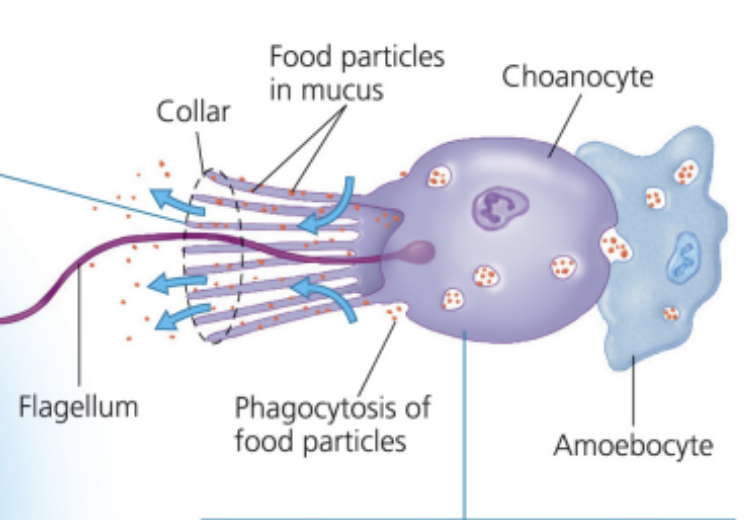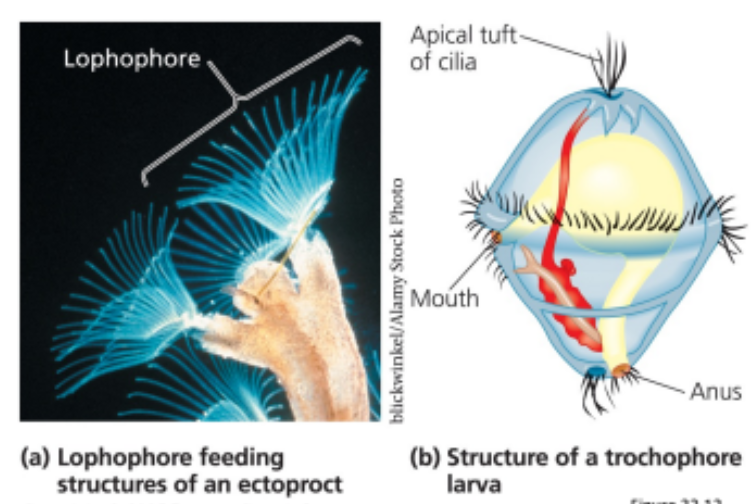BIO153H5 LEC 14-15 Animal body & development
1/54
There's no tags or description
Looks like no tags are added yet.
Name | Mastery | Learn | Test | Matching | Spaced |
|---|
No study sessions yet.
55 Terms
3 Eukaryotic Kingdoms
Plantae
Fungi
Animalia (Metazoa)
Plantae
Photoautotrophs that fix CO2 with water and sunlight
Fungi
Chemoheterotrophic decomposers that digest food outside their body and absorb nutrients
Animalia (Metazoa)
chemoheterotrophic hunters that internalize food for digestion
Similarities between kingdoms
all plants and animals as well as some fungi are multicellular
difference between animals vs. plants and fungi
animals do not have cellulose, or chitin cell walls for structural support
instead, animals secrete compounds like collagen for structural strength
haploid, multicellular form does not exist for animals → life cycle almost exclusively dominated by multicellular, diploid adult phase
KEY feature of animals EXCEPT SPONGES
digestive tract → bag in animal body that stores and digests food
central to animal embryo
Gastrulation is the beginning of:
cell differentiation
ectoderm differentiates into (JSHTNG → “jishting”)
jaws
skin
hair
teeth
nerves
germ
endoderm differentiates into (ERRD TRACTS & L EPI)
EPITHELIAL SURFACES OF
excretory,
reproductive,
respiratory,
digestive tract
liver
mesoderm differentiates into (SMCs)
skeleton
muscle
circulatory system
*NOT ALL ANIMALS HAVE A MESODERM
indeterminate cleavage
the process of embryonic cell development in bilateral animals that welcome the possibility of the embryonic cells individually becoming completely different organisms if separated
monozygotic twins are an example → division of an early-human embryo in two, resulting in two, independent fetuses
why dizygotic (fraternal) twins are/are not a result of indeterminate cleavage
dizygotic twins occur when two separate eggs are fertilized independently, thus, the twins did NOT formerly arise from the same, early-human embryo
body plans & symmetry types
fundamental shapes/layouts of animal bodies
radial symmetry
bilateral symmetry
asymmetry
radial symmetry
body arranged around a single, top-down axis passing through the center of the body
radiating body parts from the central axis
equal interaction with the environment from all sides
organisms with radial symmetry
sessile → living attached to a surface: hydra, sea anemone
planktonic → drifting/weakly swimming: jellyfish
bilateral symmetry
body parts arranged along two axes
cranial-caudal (head-tail, respectively)
ventral-dorsal (anterior-posterior, respectively)
together, the axes form a plane that separates the left side from the right side in a symmetrical fashion
animals with bilateral symmetry pack sensory equipment and CNS at the end of the head
organisms with bilateral symmetry
humans
humans → palms are ventral, back of palms are dorsal
asymmetry & organisms
sponges don’t have obvious symmetrical axes
basal group of the animal kingdom that diverged the earliest from the rest of the animals
what do sponges/Porifera lack that makes them the basal group of the Animalia Kingdom
true tissues → muscles and nerves
what do all Eumetezoa (non-sponges/Porifera) have in common
true tissues → muscles and nerves
are most animals vertebrates or invertebrates
95% invertebrates → only some Chordata members are vertebrates
two groups of Eumetazoa
Basal → radial symmetry (i.e., Cnidarians like hydra and jellyfish)
Bilateria (all other Eumetazoa)
major clades of Bilateria + basal group
basal: Acoela
major clades (dichotomies in order)
Deuterostomia: Chordata, Hemichordata, Echinodermata
Lophotrochozoa (polytomous descendants): Platyhelminthes, Rotifera, Ectoprocta, Brachiopoda, Annelida, Mollusca
Ecdysozoa: Arthropoda, Nematoda
Deuterostomia groups (CHE dichotomies in order) & organisms
Chordata
Hemichordata
Echinodermata
i.e.,
starfish, human
Lophotrochozoa groups (PREBAM polytomous) & organisms
Platyhelminthes
Rotifera
Ectoprocta
Brachiopoda
Annelida
Mollusca
i.e.,
clams, squids, snails, slugs, earthworms, tapeworms, flatworm like planaria, leeches
Ecdysozoa groups (AN) & organisms
Arthropoda
Nematoda
i.e.,
crabs, spiders, nematodes, butterflies
Salpingoeca rosetta
a colony-forming Choanoflagellate
has proteins that can stick together
its cells differentiate (colonial, individually-swimming) based on cues
being studied to investigate multicellular animal origins
sponge characteristics
sedentary suspension feeders
draws in water from side pores and erects from central cavity
filters food particles in water
No highly differentiated tissues like eumetazoans
sponge body made of two layers of cells (epidermis and choanocytes) separated by mesohyl
no need for circulatory system because they have adequate access to water
sponge has amoebocytes wedged into mesohyl so that the nutrients in by choanocytes can be transported throughout the sponge body
osculum is the opening of the cavity

parts of choanocytes
flagellum for drawing in water
collar projections around flagellum for capturing food
choanocyte (head) for phagocytosis
amoebocyte for circulation of nutrients throughout sponge body

vertebrate specific traits
backbone
hinged jaws
limbs with digits
why are there select exceptions to all Eumetazoa having differentiated tissues and digestive tracts?
diverse morphology and physiology of Lophotrochozoa and Ecdysozoa that resulted in homologous and analogous traits, gain and loss of many traits
this is why MOLECULAR PHYLOGENY IS BEST FOR DETERMINING ANIMAL LINEAGE
which group has the most body form diversity?
Lophotrochozoa
lophophores
ciliated feeding tentacles in some lophotrochozoans
trochophore larva
developmental stage that some lophotrochozoans go through
anus
mouth
atypical cilia tuft

which Bilateria group has a cuticle exoskeleton?
Ecdysozoa
undergo moulting/ecdysis
which group has the most species-rich diversity?
Ecdysozoa
more species than all other eukaryotes, combined!
most diverse phylum
arthropoda
second most diverse phylum
mollusca
arthropod classes & general characteristics
crustaceans → mainly aquatic
insects → mainly terrestrial
generally undergo moulting/ecdysis
why moulting is dangerous
soft arthropods are vulnerable → new shells/skins might not be developed in time before predation
i.e., soft-shell crabs are those that have a soft-shell right after moulting
what class co-evolved with angiosperms
insects → nourished by nectar → pollinate flowers → mutualism
insect body plan
segmented
head
thorax
post-genital region
usually one or two pairs of wings on the dorsal side of the thorax
wings are cuticular extensions
can still have three pairs of legs while having wings
why insect wings are considered convergent evolution to bird species and non-insect, wing-bearing creatures
insects did not have to sacrifice legs to gain wings unlike birds and bats whose wings are modified limbs/forearms
incomplete metamorphosis & sample organisms
several moults via metamorphosis before becoming the full, adult form
could resemble adults but be smaller, lack certain traits like wings, etc.
grasshoppers, praying mantises, lice, cockroaches, dragonflies
complete metamorphosis
stepwise growth of larva into adult via pupal stage
pupal stage is what metamorphosis occurs, breaking down larval tissues and building new adult body
wasps, bees, butterflies, beetles, flies
larval stages are specialized for eating and look completely different from adult
caterpillar, maggot
adult is specialized for reproduction and dispersal
Arthropod body
segmented body with jointed appendages attached (making antennae, pincers, legs, etc.)
pair of compound eyes (multi-lens)
cuticle-coated body and joints
mollusc phylum characteristics
snails, slugs, clams, octopuses, squids
mostly marine, some freshwater and terrestrial
soft-bodied
calcium carbonate excretion to make shell (lost or internalized in other species, i.e., squids)
mollusc body characteristics
visceral mass → contains many internal organs
mantle → covers visceral mass and secretes shell
foot → for movement and attachment
mollusc mantle notable characteristcs
may extend beyond visceral mass, creating a hollow mantle cavity
located in the mantle cavity are gills, the anus and excretory organs
bivalves physiology
aquatic suspension feeders such as clams, oysters, mussels, scallops
two shells connected by a hinge clamped shut by muscles
gills used for feeding and gas exchange
incurrent siphon for inhaling water
excurrent siphon for exhaling water
gill trap food as water passes through
low mobility → can flap valves to swim
cephalopods
INVERTED bivalves
aquatic hunters like octopus and squid
mantle is on the outer surface (shells are minimized, internalized, or lost)
foot evolved to tentacles and parts of the excurrent siphon
mantle contracts to eject water from the excurrent siphon and propel animal forward
muscular siphon can be pointed multiple directions
draws water into mantle cavity through incurrent siphon
chromatophores on the skin help with signaling and camouflage

nematodes
worms
found in many moist habitats (tissues of plants and animals, body fluids, aquatic environments, soil)
free-living, parastic
i.e., Caenorhabditis elegans, Trichinella spiralis
Caenorhabditis elegans
adults have 959-1033 cells (gender-dependent)
developmental pathways and locations of all cells have been mapped
really useful for developmental biology and medical research
Trichinella spiralis
parasite found in muscles of pork